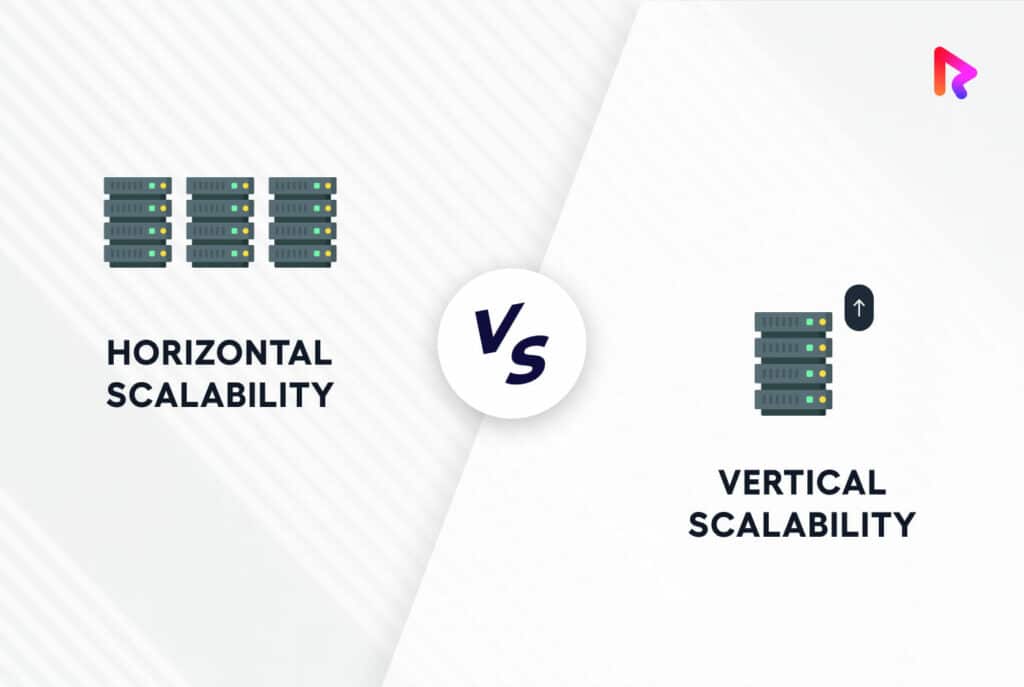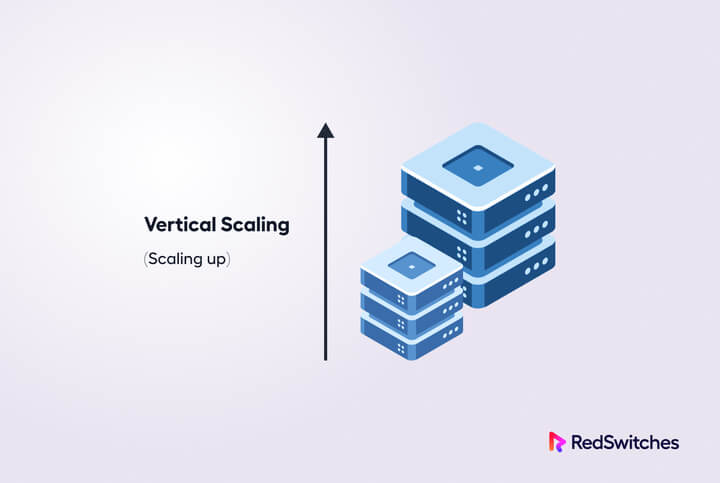Do you know that about 3+ billion people use social media every day?
On a related note, in just 60 seconds, people spend $9,305,555 in online shopping.
These mind-blowing statistics prove that online businesses are growing at breakneck speed and will not take a dip anytime soon. So, suppose your business website or SaaS app is getting popular with a regular increase in visitors. In that case, you should ensure that the visitors can enjoy your website’s visit without any interruptions or outages.
Table Of Content
- What Is Scalability?
- What Is Horizontal Scaling?
- What is Vertical Scaling?
- Vertical Scaling vs Horizontal Scaling: Which Should You Choose, And When
- Cost: The Final Determinant (In Most Cases)
- Conclusion
- FAQs
How do you do it?
And how the two approaches to scalability – horizontal scaling and vertical scaling help your website cater to the growing number of visitors. This article will answer these and other related questions about vertical vs horizontal scaling that may pop up in your head.
Let’s start with the basic definition of scalability.
What Is Scalability?
Scalability is the ability to expand the system’s existing configuration to handle the increasing load. Scaling can be done by adding hardware or upgrading the current system configuration. There are two major ways to accomplish scaling – vertical scaling and horizontal scaling.
These two ways differ in the approach to adding resources to the infrastructure. First, let’s understand how these two differ from each other.
What Is Horizontal Scaling?
Horizontal scaling is a strategy used to enhance the performance of a dedicated server node by adding more server instances to the existing pool of servers so that the load can be equally distributed. Horizontal scaling is also known as scaling out the infrastructure.
In horizontal scaling, we do not change the capacity of the individual server. Instead, we decrease the load on individual servers. We implement several connected ideas to achieve this effect, such as a distributed file system, clustering, and load–balancing.
Get a Pre-Optimized Dedicated Server
Blazing Fast Speed and Fully Managed Server Like Never Before
Some reasons businesses choose to scale horizontally include an increase in their I/O concurrency, the need to reduce the load on existing nodes, and the requirement to expand disk capacity. Out of the two scaling options, horizontal scaling is considerably easy as you simply add more machines to the existing infrastructure. You should note that the data is partitioned among the nodes, with each node containing only one part of the data.
A common scenario where horizontal scaling works the best is when your business website starts receiving a significantly large number of visitors. This additional traffic increases stress on your existing infrastructure, and the website starts to slow down.
To counter this slowdown, you can add another server to the network. This way, the workload is distributed evenly among the servers.
The recent increase in online traffic has made many popular websites use horizontal scaling. The list includes instantly recognizable names such as Gmail and YouTube, Yahoo, Facebook, eBay, and Amazon.
Cassandra and MongoDB are two great examples of horizontal scaling solutions.
Advantages of Horizontal Scaling
Horizontal scaling comes with a host of benefits, such as:
- Easily scalable tools.
- Supporting linear amplifies the capacity.
- Easier to run fault tolerance.
- Easy to upgrade.
- Better use of smaller systems.
- The cost of implementing is less expensive compared to scaling up.
- Improved resilience due to the presence of discrete, multiple systems.
- Horizontal scaling can be used to implement Infinite Scale, where you can use endless instances to enable limitless growth.
Disadvantages of Horizontal Scaling
But before you jump onto the horizontal scaling bandwagon, you should know that it comes with several drawbacks, including:
- The architectural design is highly complicated.
- You might have to pay high licensing fees.
- Horizontal scaling solutions can increase your utility costs, such as cooling and electricity.
- Horizontal scaling results in a bigger footprint for your data center
- You need to invest in extra networking equipment, such as routers and switches.
What is Vertical Scaling?
Vertical Scaling is an attempt to increase the capacity of a single machine. Here the resources, such as processing power, storage, memory, and bandwidth, are added to an existing infrastructure node. Vertical Scaling is also called the Scale-up approach.
Vertical Scaling is implemented to increase the capacity of existing hardware or software capacity by adding additional resources. It can enhance your server architecture without significantly affecting your infrastructure. However, you should know that any vertical scaling scheme could get as big as the size of the individual server.
Let’s take an example of vertical scaling.
Consider that you have a SaaS application that has moved beyond the beta testing. Now, when the number of visitors increases, the demands on the server resources increase. To counter this, you can increase CPU, RAM, and bandwidth to accommodate the users. In this example, you use a vertical scaling model that can enhance the capabilities of the server and node.
As you can see, Vertical Scaling boosts the power of the individual server to handle the increasing load. However, adding more resources in Vertical Scaling is often restricted to the capacity of a single machine. Similarly, there is no partitioning of the data because it resides on a single node.
Small and mid-sized businesses widely use vertical Scaling strategy. One of the most common examples of Virtual Scaling is buying expensive hardware and using it as a Virtual Machine hypervisor. Good examples of Vertical Scaling are MySQL and Amazon RDS.
Advantages of Vertical Scaling
Here’re a few benefits of vertical scaling:
- Reduced software costs as the underlying hardware nodes often don’t increase.
- Easy Implementation.
- Lower licensing fees.
- Vertical scaling solutions often consume less power.
- Cooling costs are lower than horizontal scaling.
- Application compatibility is maintained.
Disadvantages of Vertical Scaling
On the other hand, vertical scaling solutions can have the following drawbacks:
- The limited scope of scaling.
- The risk for downtime is much higher than horizontal scaling.
- Greater risk of outages and hardware failures.
- Finite scope of upgradeability in the future.
- Severe vendor lock-in.
- The cost of implementation is expensive.
Vertical Scaling vs Horizontal Scaling: Which Should You Choose, And When
Both vertical and horizontal scaling have advantages and drawbacks. Hence, you must choose the option that best fits your needs and available resources because there is no one size fits all approach for enterprises. We recommend you the following factors that you should include in your decision-making process:
Cost
Horizontal scaling solutions could have higher up-front hardware purchase costs. Alternatively, vertical scaling is often a better fit for businesses with limited budget, and the need to quickly and inexpensively add more capacity to your infrastructure.
Future-proofing
By horizontally scaling, you can extend the performance limits by adding better equipment.
Topographic Distribution
It is unrealistic to expect all your clients to access your services from a single computer in a single place, especially if you have an international clientele. Therefore, you must scale your resources horizontally to maintain your service level agreement in this scenario.
Reliability
Horizontal scaling might provide you with a more dependable system. It ensures that you are independent of a single machine and have redundancy built into your processes. For example, when one machine malfunctions or doesn’t work, another one might be able to take over temporarily.
Cost: The Final Determinant (In Most Cases)
Regardless of your goals or the requirements of your organization, pricing may ultimately influence your choice. Although functionally speaking, horizontal scaling seems excellent; you might need help to afford it (right now). However, it’s still vital to remember that you can have additional options outside of on-premise vertical and horizontal scalability.
You can combine the two or move your company’s infrastructure to a cloud service provider, which will take care of scaling on your behalf. In the long run, the latter may be more practical and financially feasible for you.
RedSwitches has a great team of engineers who can advise you in choosing the right scalability approach and how you can move your infrastructure to managed bare-metal servers. We help you migrate your software resources so that you can enjoy faster and more future-proof bare-metal solutions for your business operations.
Conclusion
To summarize, businesses need to identify what suits their business requirements and understand the differences between these two scaling approaches, i.e., vertical and horizontal scaling, to see if their application goals fit the chosen model.
To accomplish superior performance, you can use vertical scaling, horizontal scaling, or both in a cloud environment. Many auto-scalable models are comparatively better than traditional scaling models and are well known for their performance without downtime.
Don’t want to miss a thing from us? Subscribe to our blog now!
FAQs
1- What is Horizontal Scaling?
Horizontal scaling is a strategy used to enhance the performance of the dedicated server node by adding more server instances to your existing pool of servers so that the load can be equally distributed.
2- What is the main advantage of Horizontal Scaling over scaling up?
In Horizontal scaling, the cost of implementing is less expensive compared to scaling-up.
3- What is Vertical Scaling?
Vertical Scaling is an attempt to increase the capacity of a single machine. Here the resources such as processing power, storage, memory, and more are added to an existing work unit.
4- What is the advantage of Vertical Scaling over Horizontal Scaling?
Cooling costs are lesser than horizontal scaling.



